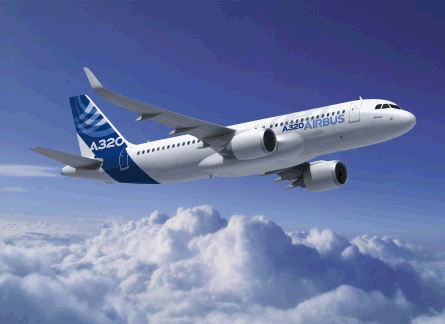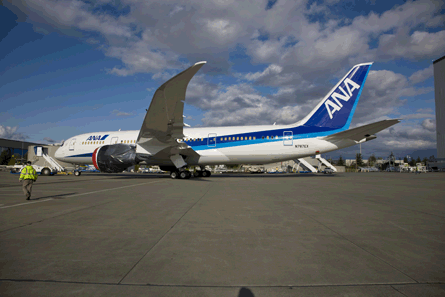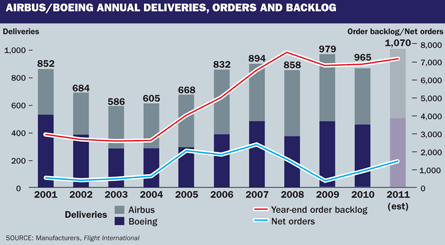For Airbus and Boeing, 2010 brought an orders bounceback that will surely continue in 2011. In 2009, Airbus won 271 net orders while its US rival notched just 142. But the relative buoyancy of the market in 2010 can be gauged from tallies the airframers posted in November. For the first 11 months of the year, Airbus recorded 388 net orders. Boeing fared even better, with a comparable figure of 489.
Regarding deliveries, the airframers' fortunes contrasted. After reaching 498 aircraft in 2009, Airbus delivered 461 in the first 11 months of 2010. In mid-December, the European airframer insisted it was "on track for another record year" with "total deliveries to be around 500". The precise figure will be confirmed in mid-January.
 |
|---|
© Airbus |
Boeing, meanwhile, recorded 420 deliveries for the first 11 months, compared with 481 in 2009. Richard Aboulafia, Teal Group's vice-president of analysis, predicts that the coming 12 months "will see higher deliveries" for commercial airframers. "Even if the market didn't want these planes, both manufacturers need the revenue to pay for their very expensive new development programmes," he says. "We should also see 747-8 and perhaps 787 deliveries help boost Boeing."
MORE DELIVERIES
The book-to-bill ratio was above one to one in 2010 and is likely to stay "well above it" in 2011, Aboulafia says.
"So, at least superficially, it will look pretty good. But two things will complicate that. One is a possible repeat of third-party finance inflating orders, just as in 2010. That's not terrible, but it's somewhat speculative. Also, we could see some [Airbus] A320neo orders that start to cannibalise the existing backlog. If Boeing goes with a 737 re-engining, we could see the same phenomenon there too."
Launched on 1 December, the A320neo was the long-awaited opening salvo in the battle to produce the best answer to airlines' narrowbody needs. It increases pressure on Boeing to commit to a re-engining of its cash-cow 737 types or plump for the riskier option of developing an all-new narrowbody type. The latter option offers the promise of an efficiency boost, but in what timeframe? With airlines' patience at a premium, re-engining looks more likely to be the favoured option.
Canada's Bombardier Aerospace, which has edged into the single-aisle space with its CSeries airliner, is also under pressure.
The Farnborough air show came and went without any new orders for the type, and Bombardier is still to add to February's Republic Airways order, which brought the CSeries' firm backlog to 90 aircraft. This context adds urgency to the outcome of Gulf Air's three-way regional jet order contest, which pits the CSeries against the Airbus A318 and Embraer E-Jets.
In October, Bombardier said it had conducted a successful test mating of an advanced composite wing portion to a composite wing box. But the launch of the A320neo has raised questions about the Bombardier type's commercial prospects. In the damning verdict of Airbus's chief salesman, John Leahy: "There is virtually no business case left for the CSeries." He says the A320neo has the same number of seats and similar fuel burn, but a wider fuselage and 1,200nm (2,200km) more range.
Bombardier has said that Airbus's re-engining move "changes nothing", and that the CSeries can avail itself of "a considerable first-mover advantage" by entering service in 2013. The A320neo is due to operate from spring 2016. Bombardier will need to secure fresh CSeries business soon if it is to dispel Leahy's notion that sales of the type have dried up. Airbus has said it is discussing potential A320neo orders with airlines and lessors, including AirAsia, GECAS, Indigo, International Lease Finance, Lufthansa and Qatar Airways.
BUFFERS ERODED
Airbus's A350 XWB type is due to enter service in the second half of 2013, but with programme buffers already eroded, it will be stunning if delays are avoided. But in its A350 campaign, the airframer will progress from pre-assembly at section and equipment level to the opening of the final assembly line.
Wing assembly will begin at Airbus's North Factory in Broughton, UK. The Rolls-Royce Trent XWB is due to fly, with A380 MSN001 as the testbed, in mid-2011, and the iron-bird hydraulic/flight control system test rig is also set to enter service this year.
The European airframer's list of 2011 targets does not stop there. It also expects to begin manufacturing and flight-testing its "sharklet" wing-tip extensions; reach 10,000 orders; and certificate a 235t A330-300 while ramping up A330 production towards a goal of nine aircraft a month by 2012. In June, Airbus delivered the first A330-200 freighter, to Etihad Airways.
 |
|---|
© BoeingDelayed dream delivery of the 787 to Japan's All Nippon Airlines has been put back |
Boeing missed a major deadline in 2010 by failing to deliver the first 787 widebody to Japan's All Nippon Airways. In August, the target shifted from the end of the year to the middle of the first quarter of 2011, because of engine-availability issues and the horizontal stabiliser needing inspections and rework. Subsequently, an electrical fire aboard a 787 led to a grounding of the test fleet.
In 2010, cancellations removed 41 787s from the Boeing backlog and turned the type's net order total negative to five aircraft.
First delivery of Boeing's 747-8 freighter also slipped out of 2010. Launch customer Cargolux is now set to receive its first in mid-2011. The delay reflected a need to resolve the low-frequency vibration occurring in "certain flight conditions". In addition, an inboard aileron actuator was not working as expected.
PROGRAMME GLITCHES
Airbus is no stranger to programme glitches, and the A380's travails continued into 2010. In May, Leahy conceded: "Airlines are making money with it; unfortunately, we're not - but we will soon." For 2011, Airbus foresees "ongoing ramp-up" in production of the type. China Southern and Korean Airlines will join the ranks of A380 operators this year.
Meanwhile, the total production rate of Airbus's cash-cow A320 narrowbodies is set to rise from 36 to 38 a month in August and to 40 in early 2012. The plan foresees a final assembly line in China producing four aircraft a month by the end of the year.
Boeing intends to lift 737 production from 31.5 to 35 a month by early 2012 and to 38 by the second quarter of 2013. Monthly output of 777s is to increase from five to seven in mid-2011, and to 8.3 in the first quarter of 2013.
|
|---|
 |
"We expect 2011 to be another good year for our industry," says Randy Tinseth, vice-president of marketing at Boeing Commercial Airplanes. "We project that the world economy will continue to expand, and that both passenger and cargo traffic will grow above the long-term expected trend." The International Air Transport Association is forecasting continued profitability for airlines in 2011, notes Tinseth. "We don't forecast expected orders, but clearly a good market for our customers means healthy order levels for Boeing and growth in our services business," he adds.
In aircraft finance, 2011 will bring a need to adjust to the Organisation for Economic Co-operation and Development's new aircraft sector understanding agreement on export credits for civil aircraft, says Kostya Zolotusky, managing director of capital markets at Boeing Capital. "In the light of significant support provided by ECAs [export credit agencies] in 2009 and 2010 and the anticipated shift towards commercial finance in 2011, we are going to see increased demand on all other aircraft-financing sources," he says. "Commercial bank debt and capital markets are likely to absorb the majority of the shift from ECA to commercial finance."
More widespread endorsement of the Cape Town Convention - which regulates cross-border leasing of mobile assets - will also change the game, Zolotusky adds.
"We anticipate continued growth in regional banking support for their domestic airlines," he says. "But we believe capital markets will be the most important source of innovation and liquidity over the next decade. New structures to finance lessors, as well as the Cape Town treaty becoming ubiquitous, should expand capital markets' role in aircraft finance."
Source: Flight International

















